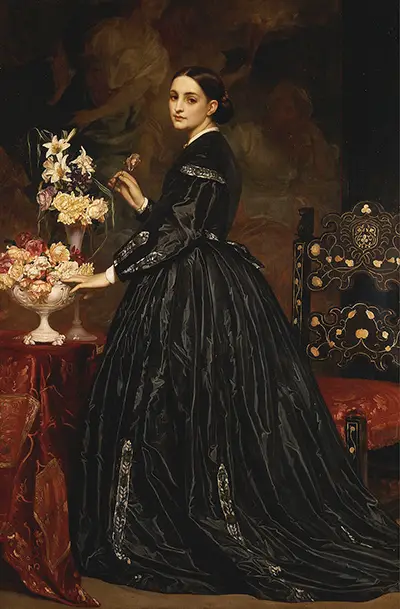 Buy Art Prints Now
Buy Art Prints Nowfrom Amazon
* As an Amazon Associate, and partner with Google Adsense and Ezoic, I earn from qualifying purchases.
Mrs James Guthrie, an artwork by the British creator Frederic Leighton, is dated back to 1864-1865 and at first, glance entails a subject to whom the painting was named after in an elegant black dress.
Flowers, vases, an embroidered tablecloth, an ornate chair, and a framework of history as the backdrop. The items were probably furnishings in the artist’s studio in St. John's Wood which suggests a possible location on where the painting was done. Frederic had to plan the sitting for the painting in October 1864, right after Mrs Guthrie had just recovered from giving birth to her fifth daughter. He first had to create an underneath painting, a self-coloured achromatic painting that helps fix the composition on the canvas and the extensiveness to the drawing, therefore a clear visual aesthetic to the mural.
The addition of colour on the painting is done when it is fully dry. The base of the image was done with subtle colour, the brown colour, which is glowy and cordial. This effect makes her appear very lifelike but also frozen in a moment. The subject stands out because she blends seamlessly into the background of murky brown brushstrokes of the oil painting done on canvas. The artist used the Dead Painting technique to achieve this look. It is a technique that is rarely practised today, it involves the use of no colour or dull colours. This gives the base a smoothly defined pattern to the partition painting. When illuminated, it creates an ambience to a well-lit room. The combination of the colour schemes creates a beautiful semblance.
The portrait's physical dimensions are 83 by 54 1/2 inches (210.8 by 138.4 cm) and the frame measures 96 by 68 inches (243.8 by 172.7 cm) and has a possible monogrammed signature on the lower right on top of the chair leg. The painting suggests a refined world of beauty, art, and culture. This painting was part of the Pre-Raphaelite art and movement which even thought was short-lived, was highly influential and focused on rejecting artificial mannerism painting styles and wanted to create more genuine and humble representations of their subjects. They focused on elaborate design, romanticism, symbolism, and nature.
One of the most notable works to be associated with Leighton was the Flaming June and became the most recognisable picture of his skill. The founder of the Courtauld Institute of Arts, Samuel Courtauld, was inspired by his work and termed it as the most wonderful painting to ever exist. The painting depicts a sleeping woman, clothed in transparent material which is stunningly rich in colours and is surrounded in perfectly recreated marble surroundings bathed in natural light which was a trademark of his work.




